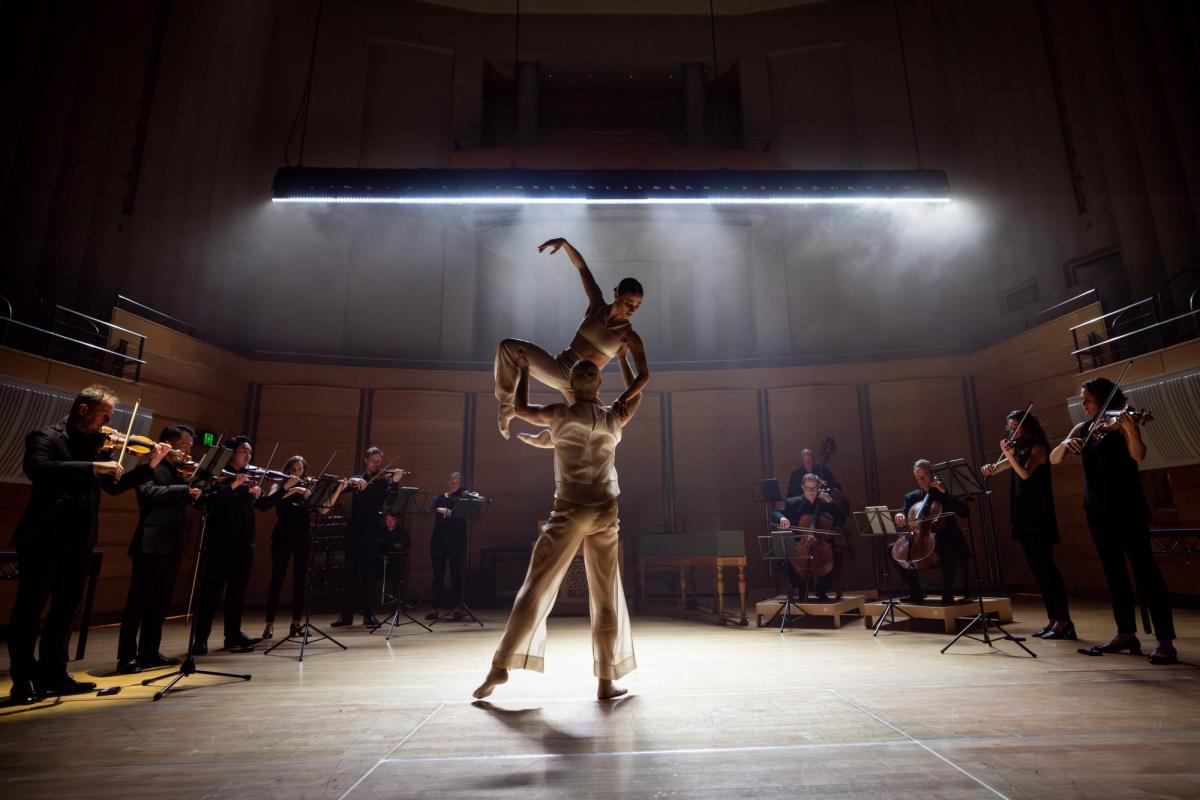‘That was different.’ ‘Wasn’t that something?’ ‘Sublime and mysterious.’ ‘We’ve just experienced something special.’ These were comments overheard from some of the delighted members of the capacity audience at the Adelaide Town Hall as they were leaving after the conclusion of Silence & Rapture. Perfectly named.
Seventy-five minutes of intense creative collaboration is superbly performed by 12 members of the Australian Chamber Orchestra, two dancers from the Sydney Dance Company and one singer. Silence & Rapture offers much, delivers more, but it isn’t without its issues.
The program comprises pieces by Johann Sebastian Bach juxtaposed with pieces by Arvo Pärt. Even though Bach and Pärt lived hundreds of years apart and were motivated by very different contexts, they are ideally suited “bedfellows” in this expertly curated program.
The superb program notes remark that the narrative of the music choices ‘follows the path of a Lutheran metaphor … the world as a pendulum swinging downward, from the natural world of Hope and Temptation (Garden of Eden), down to Tragedy and Passion (Garden of Gethsemane), then upward again to Resurrection and Redemption (Garden of Heaven)’.
The music in each of these three “chapters” are of diverse forms: canon, cantata, sonata, oratorio aria, song, suite (for cello – and cellist Timo-Veikko Valve is superb!), fugue, tone poem and more “liberated” forms (including the tintinnabula style championed by Pärt).
With such a panoply of musical styles, there is a risk of a lack of coherence, but in execution it all fits together perfectly. Sometimes there is no break between the pieces and one flows immediately into the other. In these instances, the contrasting styles adds to the emotional impact.
Read: The rapturous reunion of the Sydney Dance Company and Australian Chamber Orchestra
The concert is well lit by designer Damien Cooper and technician Joseph Cox. Colours are empathetic with the mood of the music and the underlying messaging in the song texts. The timing in transitioning from one lighting state to the next is precise and in near perfect synchronisation with the motion of the instrumentalists, the dancers and the singer.
Countertenor Iestyn Davies is superlative in everything he performs. He, like the two dancers Liam Green and Emily Seymour, is dressed simply – almost austerely – and he catches and uses the light to accentuate his physical form to underline the solemnity of what he is singing.
Not only is Davies a fine singer, with rich and beautifully rounded tones across his full range and with a silky relaxed vibrato, he’s also an actor. He embodies the songs. There is no such thing as stand and sing. His performance of the aria ‘Erbame Dich’ from Bach’s St Matthew Passion, BWV244, shows him at the top of his game.
His heartfelt rendition of Pärt’s deceptively difficult musical setting of the Robert Burns poem ‘My Heart’s in the Highlands’ is a transcendent oasis in the program and dancers Green and Seymour accompany him with a complex figurative routine that exemplifies the diversity of the geographical context of the poetry. Again, the lighting design – an icy-white schema – enhances the overall effect.
Green and Seymour dance solos and duets at various places in the program. Some choreography is reminiscent of the complex staccato routines one associates with performances of Philip Glass’ Einstein on the Beach, as choreographed by Leigh Warren.
It is, however, frequently an intellectual challenge to “decode” Rafael Bonachela’s choreography in the context of the music and the sung text, and at times this borders on diverting the audience’s attention, rather than consolidating it.
Read: Exhibition review: (SC)OOT(ER)ING around, TarraWarra Museum of Art
By contrast, the dance that accompanies Bach’s ‘Fuga a 3 Soggetti’ from the Art of Fugue, BWV1080, is inspired. The fugue was never finished by Bach and the genius of the collaboration between Bonachela and ACO director Richard Tognetti is to finish it with dance. It is indeed silence and rapture!
The concert ends with a section from Paul Hindemith’s Trauermusik, which is accompanied by the loveliest pas de deux, gracefully executed by Green and Seymour.
When it finished, the Adelaide audience reacted with thunderous applause and wolf whistles as if they were at a rock concert. The appreciative smile on Tognetti’s face was palpable.
Silence & Rapture
Adelaide Town Hall
Australian Chamber Orchestra in collaboration with Sydney Dance Company featuring countertenor Iestyn Davies and dancers Liam Green and Emily Seymour, under the direction of Richard Tognetti, ACO artistic director and violin, and Rafael Bonachela, SDC artistic director and choreographer.
Following performances at Sydney City Recital Hall, Melbourne Recital Hall and Arts Centre, and Adelaide Town Hall, Silence & Rapture will tour to Perth Concert Hall (14 August), Canberra Llewellyn Hall (17 August), Sydney Opera House (18 August) and Brisbane QPAC Concert Hall (19 August).





